#Oneota ceramics
Photo

This reconstructed pot, designated Vessel 46, was found in Feature 199 during the 2012 excavations under STH 35 in downtown Onalaska, Wisconsin. The nearly complete vessel is a classic example of Brice Prairie phase Perrot Punctate. The rim is moderately high for the vessel size and is slightly outward-flaring, with small, interior tool impressions. Two small loop handles attach at the lip top on opposite sides. The shoulder has alternating panels of vertical tool trails; nested chevrons (about eight) with a border of long, slash punctations below; vertical tool trails; and four horizontal tool trails with a lower border of long slash punctations, and short vertical tool trails below those. There are four nested chevron panels, one under each handle and the others midway between them. The rim radius is 7 cm, flaring slightly to 7.5 cm at the handles.
#archaeology#archeology#Pottery#Ceramics#Oneota#Oneota pottery#Oneota ceramics#Perrot Punctate#Brice Prairie phase
52 notes
·
View notes
Photo
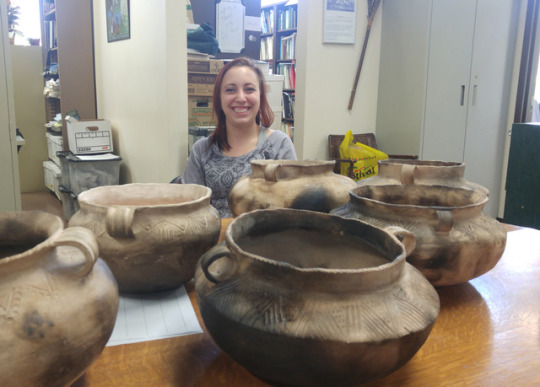
#tbt to a month ago when we visited @uwlmvac, where Sarah Schultz has been experimenting with re-creating Oneota-style pottery vessels! Sarah donated one to us for our teaching collection and one to the Baxoje Wosgąci: Iowa Tribal Museum and Culture Center. It was great to visit our WI colleagues!
#iowa#wisconsin#archaeology#oneota#experimental archaeology#pottery#ceramics#art#tbt#throwback thursday
14 notes
·
View notes
Text
March 2020 Association for Advancement of Archaeology Events

March 3, 2020 - 1:45pm
The Illinois Valley Archaeological Society (IVAS) Lecture
“Power, Resistance, and Abandonment: The 14th Century Central Illinois River Valley”
John Flood, Graduate Student, Indiana University-Purdue University Indianapolis, Department of Anthropology
The Mississippian Period occupation of the central Illinois River valley (CIRV) represents nearly a half millennium of culture contact, negotiation, and redefinition between in situ ancestral groups and immigrants from other parts of the Midwest. During the late 13th and early 14th centuries, the Bold Counselor Oneota immigrated to the Illinois Valley, blending their lifeways with Mississippian ones around the confluence of the Spoon and Illinois Rivers. Meanwhile, further downstream, between the La Moine River and McKee Creek, a string of Mississippian villages and complexes developed that are devoid of evidence for interaction with the Oneota. Known as the LaMoine River Polity, these Mississippian sites are occupied for less than a century before the region becomes depopulated as part of the Vacant Quarter. This study synthesizes recent research to provide a framework for understanding the La Moine polity’s development and identity during periods of climatic instability and immigration.
John Flood is a graduate student at Indiana University-Purdue University Indianapolis studying under Dr. Jeremy Wilson. His research combines geospatial analyses and remote sensing with material culture studies to understand community and regional changes during the Mississippian Period. John’s archaeological career started at Lawrenz Gun Club (Mound Lake) in Cass County, IL, and feels lucky to work in an area with strong professional and collector relationships.
The Illinois State Museum—Dickson Mounds is located between Lewistown and Havana off Illinois Routes 78 and 97. The museum is open free to the public from 8:30 a.m. to 5:00 p.m. every day. Tours and special programs are available for groups with reservations. For more information call 309.547.3721 or TTY 217.782.9175 or visit the museum's web site at http://www.illinoisstatemuseum.org/content/welcome-dickson-mounds. Also check out weekly updates on Facebook at “Illinois State Museum – Dickson Mounds”.

March 3, 7:30 PM (Moved from February due to weather)
Quad Cities Archaeological Society Lecture
"Of Little Archaeological Value”Jennifer Mack
In 1958, heavy machinery borrowing soil for the construction of Interstate 29 disturbed human remains buried on a bluff in Sioux City’s South Ravine Park. The hurried salvage excavation was punctuated by looting episodes and provoked a dispute between Reynold Ruppé (soon to be Iowa’s first State Archaeologist) and Sioux City officials over ownership of finds from the site. The recovered skeletal remains and objects were eventually divided between the Sioux City Public Museum and the University of Iowa, though all involved agreed the materials were relatively recent and “of little archaeological value.”
In the 60 years since their discovery, the human remains have been misplaced twice, and many artifacts recovered from the burial ground have gone missing. In 2018, Bioarchaeology Program Director Lara Noldner arranged for the return of the remains from Tennessee to Iowa. Thorough analysis and background research was made possible by the generous support of the Iowa Department of Transportation. This presentation will shed light on the history of the South Ravine Burial Site and the individuals whose graves inspired the children’s novel, Secret of the Unknown Fifteen.
After obtaining a BA in History and Art History from Emory University in 1996, Jennifer Mack worked as a field archaeologist for six years. From 2004-2005, she received additional training in Human Osteology at the University of West Florida. She has specialized in mortuary archaeology since 2007, and has worked for the OSA off and on since 2008. The book she co-authored with Robin Lillie, Dubuque's Forgotten Cemetery: Excavating a Nineteenth-century Burial Ground in a Twenty-first-century City, received the 2017 James Deetz book award presented by the Society for Historical Archaeology. Jennifer is currently pursuing a PhD through the University of Exeter.
Singing Bird Nature Center
1510 46th Ave, Rock Island, Illinoishttps://archaeology.uiowa.edu/event/49636
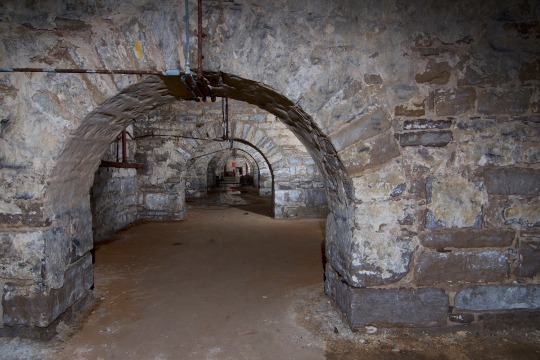
March 4, 7:00 PM,
Mound City Archaeological Society Lecture
“Reconstructing the Lost Lemp Breweries”
Chris Naffziger
Adam Lemp founded the Western Brewery in 1840 on the Riverfront, and it soon grew to be one of the largest in St. Louis. Today, the original brewery on the Levee is gone, and most of the buildings on Cherokee Street have been replaced by later Twentieth Century Lemp Brewery structures. Through the use of old photographs, maps, primary source documents and examination of the old Lemp lagering caves and cellars, we can reconstruct the original appearance and structure of these lost historic structures.
Missouri History Museum
5700 Lindell Blvd, St. Louis, Missouri
https://mohistory.org/events/reconstructing-lemp-breweries

March 19, 7:00 PM
East Central Illinois Archaeological Society Lecture
"The 2019 Noble-Weiting Site Investigations”
Dr. Robert McCullough
Urbana Free Library
Urbana, Illinois
https://www.facebook.com/IllinoisArch/

Thursday, March 19, 7:30 PM
South Suburban Archaeological Society Lecture
"The Archaeology of the River Thames”
Fred G. Christensen
England's heartland river is exceptionally rich in archaeological finds. From its source in the Cotswolds past gravel beds revealing artifacts of all eras, through much-excavated London, to sites like Swanscombe near the estuary, the Thames has yielded evidence of half a million years of human activity.
Fred G. Christensen has hiked the full length of the Thames, filming it for class presentations, and will discuss its archaeological heritage in this talk. He will emphasize the area around Dorchester, south of Oxford, featuring artifacts and earthworks from every era of prehistory. Paleolithic hand axes, Neolithic henges, Celtic hill forts and Roman towns will all make their appearance in this presentation.
Mr. Christensen is a former Instructor at the Universities of Illinois and Kentucky, and retired as a Lieutenant Colonel after 28 years (including 5 years active duty) in the U.S. Army Reserves. Since retirement, he has taught adult education courses, and currently serves as President of the East Central Illinois Archaeological Society (ECIAS).
Marie Irwin Community Center
18120 Highland Avenue,
Homewood, IL
https://southsuburbanarchsociety.weebly.com/upcoming-events.html

March 22, 2:00 PM
Cahokia Winter Lecture Series Lecture
“New Perspectives on the Poverty Point World Heritage Site”
Michael Hargrave, PhD, US Army Corps of Engineers
Cahokia Mounds Interpretive Center
Collinsville, Ill.
https://cahokiamounds.org/events/lecture-new-perspectives-on-the-poverty-point-world-heritage-site/

March 29, 3:00 PM
Chicago Archaeological Society Lecture
"Exploring the 14th Century Upper Mississippian Village of Noble-Wieting"
Dr. Logan Miller
Evanston Public Library
Evanston, Illinois
https://www.chicagoarchaeologicalsociety.com/p/events.html
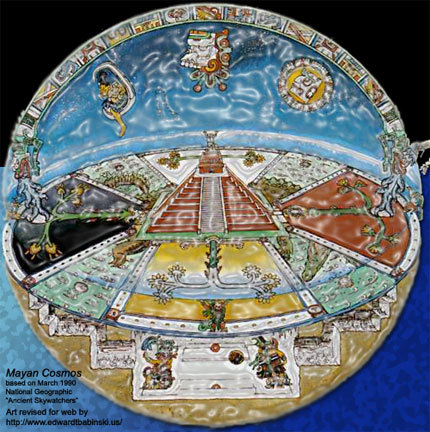
FRIENDS OF THE IAAA
March 5, 7:00 PM
Chicago AIA Lecture
"The Ancient Maya Sky: Cosmology And Creation Revealed And Revitalized”
Elizabeth I. Pope
The Ancient Maya have long been recognized as expert astronomers who closely tracked and documented the movements of celestial bodies. This was not merely for scientific inquiry but reflects a worldview where the night sky was the realm of supernatural beings upon which all life depended. Within the changing patterns of the celestial realm, the ancient Maya saw a narrative of the creation of the cosmos displayed. In this way, the sacred time of creation was ever present, ensuring the perpetuation of the original cosmic design.
Focusing on ancient Maya representations of the celestial realm displayed in works of art, architecture, and ritual performance, this lecture will present Maya depictions and interpretation of the night sky. Furthermore, it will explore how the creation mythology revealed in celestial realm was a touchstone for Maya kings as an expression of sacred authority, and asserted the essential connection between the human world and the supernatural realm.
The Webster Lecture is free but requires an advanced ticket reservation. Tickets will be available online beginning Thursday, February 27, please check the Adler Planetarium website to make reservations.
Exclusive free tickets for AIA members to the Webster lecture! Now available at this link: https://tickets.adlerplanetarium.org/webstore/shop/viewItems.aspx?cg=AST&c=22WMLM. Limit two tickets per order. Please do not wait too long, as tickets will become available to the general public by Feb. 27.
Adler Planetarium
1300 S Lake Shore Drive
Chicago, IL

March 25, 2020 at 6 PM
Packwaukee Public Library Lecture
"Burial Mounds of the Buffalo Lake Area”
Buffalo Lake is a nearly 12-mile section of the Fox River that was dammed in the late-19th Century. Nearly a thousand years before, it was heavily utilized by Indigenous people for abundant rich resources and a place to bury their dead in elaborately constructed burial mounds. Archaeologists in the early-1900s excavated the mounds in order to understand their construction and how people were buried inside them. Artifacts were collected but never fully analyzed until nearly a century later. This presentation looks at a ceramic artifacts recovered from the early archaeological investigations, and help understand why past populations gathered at Buffalo Lake.
Join Seth Taft, archaeologist from the Museum Archaeology Program of the Wisconsin Historical Society, as he presents on one of Wisconsin’s most unique settings and how ceramics recovered from archaeology sites at Buffalo Lake can help understand some of the past human activity in Marquette County.
https://www.facebook.com/events/9259630050765505/
Packwaukee Public Library
N3511 State Street,
Packwaukee, Wisconsin
https://www.facebook.com/events/9259630050765505/
IAAA Facebook Page
http://www.facebook.com/IAAAnews
0 notes
Text
Shell-Tempered Pottery From the Upper Mississippi River Valley
Author: Robert F. Boszhardt
Abstract: Shell-tempered ceramics first appear in the archaeological record of the upper Mississippi River Valley in the post-Hopeivellian period (ca. A.D. 250-500) of the Woodland Tradition as a minority ware in northwestern Illinois and south-central Wisconsin. Following a five-century hiatus, shell tempering was reintroduced via Middle Mississippian expansion from the American Bottom into the northern hinterland about A.D. 1000-1050. The following century witnessed the adoption of this technology by Terminal Woodland groups as they also incorporated corn agriculture into their economy. After A.D. 1150, shell tempering dominated the ceramics of the intensive agricultural Oneota Culture until French contact and the coinciding introduction of brass kettles. Experimental replication of Oneota wares, coupled with archaeological evidence, offers insight into the manufacturing technology of this last prehistoric culture in this region.
0 notes
Photo

This vessel fragment from 2012 excavations in Onalaska, Wisconsin, has a short, strongly outward-flaring rim with fingertip impressions on the lip top. That's not all that makes this pottery sherd interesting, though. The design on the shoulder features (from top to bottom) two horizontal rows of ovoid punctations, a horizontal finger trail, another horizontal row of punctations, another horizontal finger trail, and another horizontal row of punctations. This design is quite unusual for the La Crosse area; however, the vessel’s paste (the clay from which it was made) and the crushed-shell temper added to improve firing both look typical for local pottery. Perhaps the potter who made the vessel was non-local, or had encountered the design elsewhere?
16 notes
·
View notes
Text

Over 9,300 pottery sherds were collected during 2008 excavations at one of the sites in the Sand Lake Archaeological District, near Onalaska, Wisconsin. Of those, nearly 160 rims and decorated body sherds were categorized into likely ceramic wares and types based on their grit or shell temper, form, and decoration. But categories created by archaeologists today to make sense of what people made in the past cannot neatly cover everything. A small group of anomalous sherds, all from different excavation units, had distinctive characteristics but defied classification into types. One grit-tempered rim (upper left) flares to a flattened lip and has a cord marked exterior surface. Another cord roughened grit-tempered sherd (upper right) thins to a rounded lip. It may fit the local Middle Woodland type Shorewood Cord Roughened. A third rim has a cord impression over a folded lip (lower right). It is grit-tempered but might also contain shell temper, a possible mix of Terminal Late Woodland and Mississippian clay preparations. One grit-tempered body sherd has parallel tool trails (lower left). It could be from a Terminal Late Woodland type vessel or from a rare grit-tempered Oneota pot.
31 notes
·
View notes
Photo
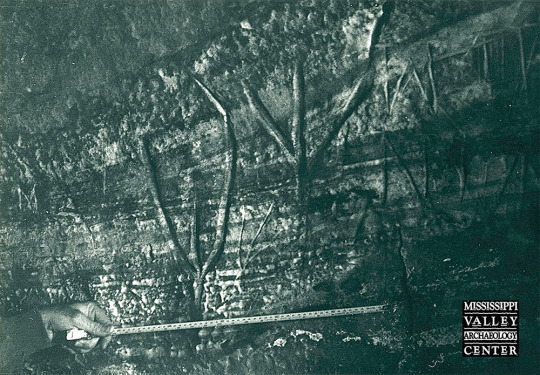
This rock art was found some years ago in a relatively large rockshelter near the Baraboo River in Juneau County. The shelter had formed along a fault-line in the local sandstone. Historic glyphs are common near the entrance, particularly on a flat panel on the north wall. Some date at least to 1907. Three large versions of "turkey track" glyphs were observed along the walls of the northern fork towards the rear of the shelter. These were probably carved by late prehistoric Native American artisans, as similar symbols have been found on rock art and Oneota ceramics across the Midwest.
7 notes
·
View notes
Photo

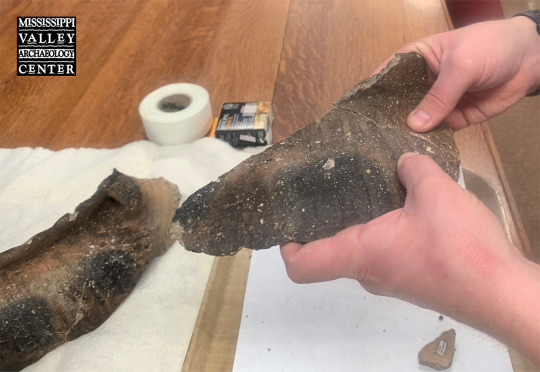
Thanks to Wendy Holtz-Leith and Erik Anderson for this week’s post –
In 2012 MVAC excavated about 500 Oneota features exposed during the reconstruction of STH 35/2nd Avenue in downtown Onalaska. One unusual discovery was a nearly complete vessel found crushed in place at the base of a feature. Vessel 45, as it was later numbered, was represented by well over a hundred fragments of varying sizes.
Reconstructing a vessel is much like putting together a three-dimensional jigsaw puzzle, with quite a few pieces missing. You typically begin with the edges, which in the case of pottery, means the rim. Rim fragments from Vessel 45 were reassembled, and decorated body pieces were glued together and attached to the rim. Then came the slow process of figuring out where the undecorated pieces went. Some parts of the vessel were easier to figure out. Sherds from the base were thicker and in some cases larger, making it easier to fit them into place.
After most of the pieces were glued into larger sections, it was time to glue those sections together to form the whole vessel. This task was complicated by three things. First, some small joining fragments were missing. Second, errors in forming a vessel’s curved shape tend to creep in during the gluing and drying. Right after gluing, refitted pieces are usually placed in a sandbox to dry, and any shift can alter the curvature, making subsequent joins difficult. Third, the exterior had scorch marks or firing smudges that made its color quite variable—sometimes even adjacent sherds were completely different colors. In the end the vessel was fully reconstructed (albeit precariously), but it was left in a few very large segments because of those subtle errors from gluing.
The reconstructed vessel is very large and slightly oblong. It has a moderately high, slightly everted (outward-flaring) rim with bold finger impressions on the lip top to exterior lip. There are two handles on opposite sides of the vessel. The shoulder decoration consists of alternating panels of 12 or 13 vertical trails made with either a finger or a broad tool, and four nested chevrons with rectangular punctations below. There are four panels of nested chevrons, one under each handle and the others midway between them. The oblong rim has a diameter of 36.5 cm (14.4 inches) at the handles and ~34 cm (13.4 inches) midway between the handles. The motif is typical of the type Perrot Punctate, with very bold lip-top impressions typical of the Pammel Creek phase, A.D. 1400–1500.
#archaeology#archeology#Oneota pottery#pottery#Oneota ceramics#ceramics#Wendy Holtz-Leith#Erik Anderson#Pottery Reconstruction#Ceramic Reconstruction
17 notes
·
View notes
Photo

This shell-tempered Oneota vessel portion was found in La Crosse County in 1991. The rim flares outward and has tool impressions on the lip top. The tool was held flat, and the impressions were made at an angle rather than being perpendicular, creating a series of diagonal dashes / / / along the lip. The shoulder has blocks of diagonal tool trails made at different angles.
8 notes
·
View notes
Photo

Throwback Thursday - Robert "Ernie" Boszhardt excavating an Oneota vessel at the Sanford Archaeological District in La Crosse, Wisconsin, summer 2001.
(Photo contributed by J. Theler.)
#archaeology#archeology#Sanford Archaeological District#Oneota#Pottery#Ceramics#Oneota pottery#Oneota ceramics
15 notes
·
View notes
Photo

A broken Oneota vessel fills a small pit-type feature uncovered during the 2002 excavations at the Meier Farm site (47LC432), near Onalaska, Wisconsin. This site was part of the Sand Lake site complex, where tens of acres of ridged agricultural fields were created in the moist soils of a trapped floodplain. Meier farm was one of the habitation areas associated with those fields. Most of the Sand Lake complex has since been obliterated by development.
#archaeology#archeology#Oneota#Oneota vessel#Oneota pottery#pottery#ceramics#Oneota ceramics#Meier Farm#Sand Lake
28 notes
·
View notes
Photo

This Oneota vessel was found in the early 2000s in an storage/refuse pit at the Sanford Archaeological District in La Crosse, Wisconsin. In profile the pit was flat bottomed with contracting walls. The design on the vessel fits a type called Brice Prairie Trailed that is most common in the earliest phase of the Oneota occupation of La Crosse: the Brice Prairie phase, ca. A.D. 1300–1400. The impressions on the interior of the lip are characteristic of Brice Prairie phase vessels. The shoulder looks as though it has round punctates above tool trails, but the round holes are actually the tops of “stab and drag” trails, where the tool was pushed into the top of the shoulder and then dragged downward. Charred plant remains from the pit yielded a corrected and calibrated radiocarbon date of A.D. 1387–1444 (70%, UGA 01751).
#archaeology#archeology#Oneota#Oneota pottery#Oneota vessel#Oneota ceramics#Sanford Archaeological District#ceramics#vessel#Brice Prairie
12 notes
·
View notes
Photo
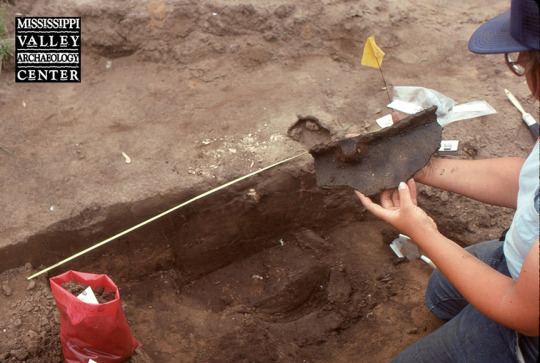
Connie Arzigian lifts an Oneota rim sherd with handle from a pit feature at the Pammel Creek site (47LC61) in May 1989. This site is the type site for the Pammel Creek phase (A.D. 1400–1500) in the local Oneota sequence. The bold finger impressions on the lip of the vessel are typical for pottery from this phase. The Pammel Creek site is located south of La Crosse, Wisconsin.
14 notes
·
View notes
Photo
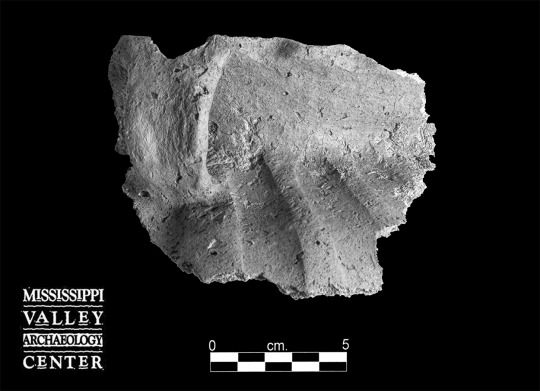
This Koshkonong Bold rim sherd was recovered from an Oneota circular basin, storage/garbage pit. It has lip top to exterior finger (wide) notches, giving the rim a pie-crust appearance. The vessel has a wide strap handle that tapers toward the bottom. The handle is attached below the lip and has no decoration. This rim dates to the Pammel Creek phase occupation of the site. Recovered during 2008 excavations at the Sand Lake Archaeological District, located north of La Crosse, Wisconsin.
#archaeology#archeology#Oneota#Koshkonong#$Pottery#Ceramics#Oneota pottery#Oneota ceramics#Sand Lake Archaeological District
8 notes
·
View notes
Photo

This Oneota vessel was excavated in 1991 from a site south of Holmen, Wisconsin that consisted of a tight cluster of up to 85 pit features situated on a sandy rise surrounded by dark compact organic soil. Evidence suggests that cultural activities of relatively short duration took place at the site somewhere ca. A.D. 1450-1650.
The vessel consists of a large rim and decorated shoulder section and a rim and handle that belongs to the same vessel but does not attach to it. The rim is 0.79 cm (.311 in) thick and 4.48 cm high (1.76 in) (measured on the vessel exterior). It is only slightly out-flaring. The lip surface is notched by placing a tool flat on the lip at a right angle to the rim. The resulting tool impressions form "dimples" on the surface of the lip. The shoulder of this vessel has shallow tool trails that are about 0.63 cm (.24 in) wide which form bands of intersecting lines. The handle has three vertical finger trails of varying width. It attaches to the rim just below (0.83 cm, .32 in) the lip and has a maximum width of 4.60 cm (1.8 in).
4 notes
·
View notes
Photo
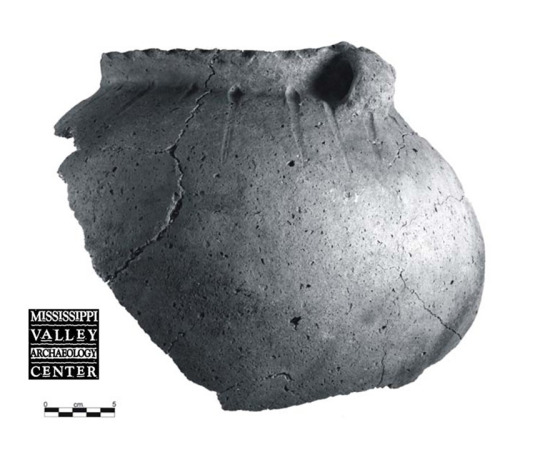
This large vessel section, called Vessel 108, was found in the early 2000s during excavations in the Sanford Archaeological District in La Crosse, Wisconsin. This late precontact Oneota site was inhabited during all three phases of the local Oneota occupation. Vessel designs and decorations provide clues to an Oneota vessel’s age. The rim of Vessel 108 has bold notching on the lip top to exterior lip, and the shoulder has a probable Pammel Creek Trailed motif of vertical finger trails. The trails begin at the top of the shoulder and are wide at the top, trailing off to nothing by the break in the shoulder. The vessel also has an undecorated strap handle attached just below the lip and a short rim height of 33.6 mm. The design and decoration—especially the bold impressions on the lip—are characteristic of the Pammel Creek phase (ca. AD 1400–1500), the middle phase of the Oneota occupation.
#archaeology#archeology#Oneota#ceramics#pottery#Oneota ceramics#Oneota pottery#Sanford Archaeological District#Pammel Creek Trailed
10 notes
·
View notes